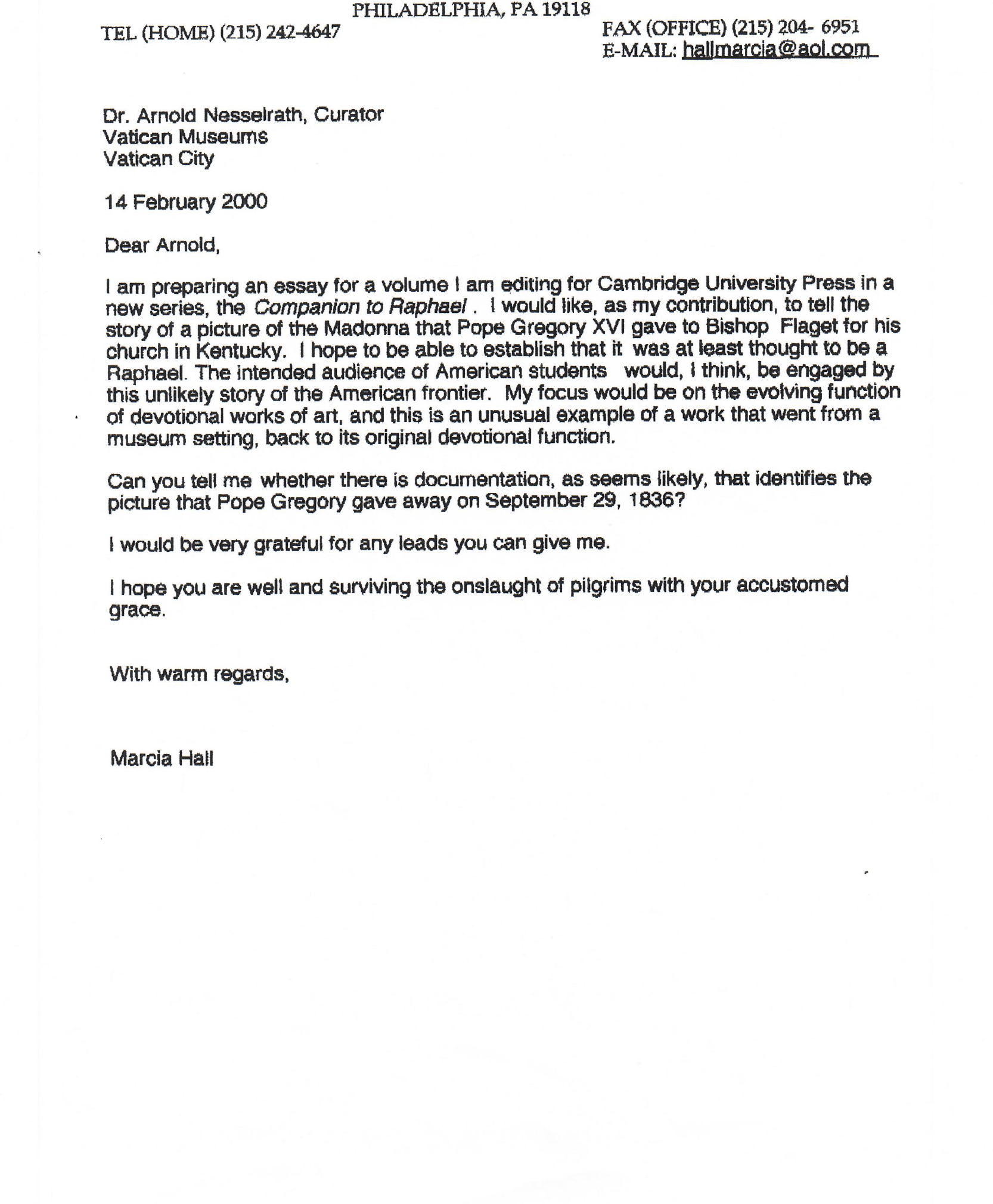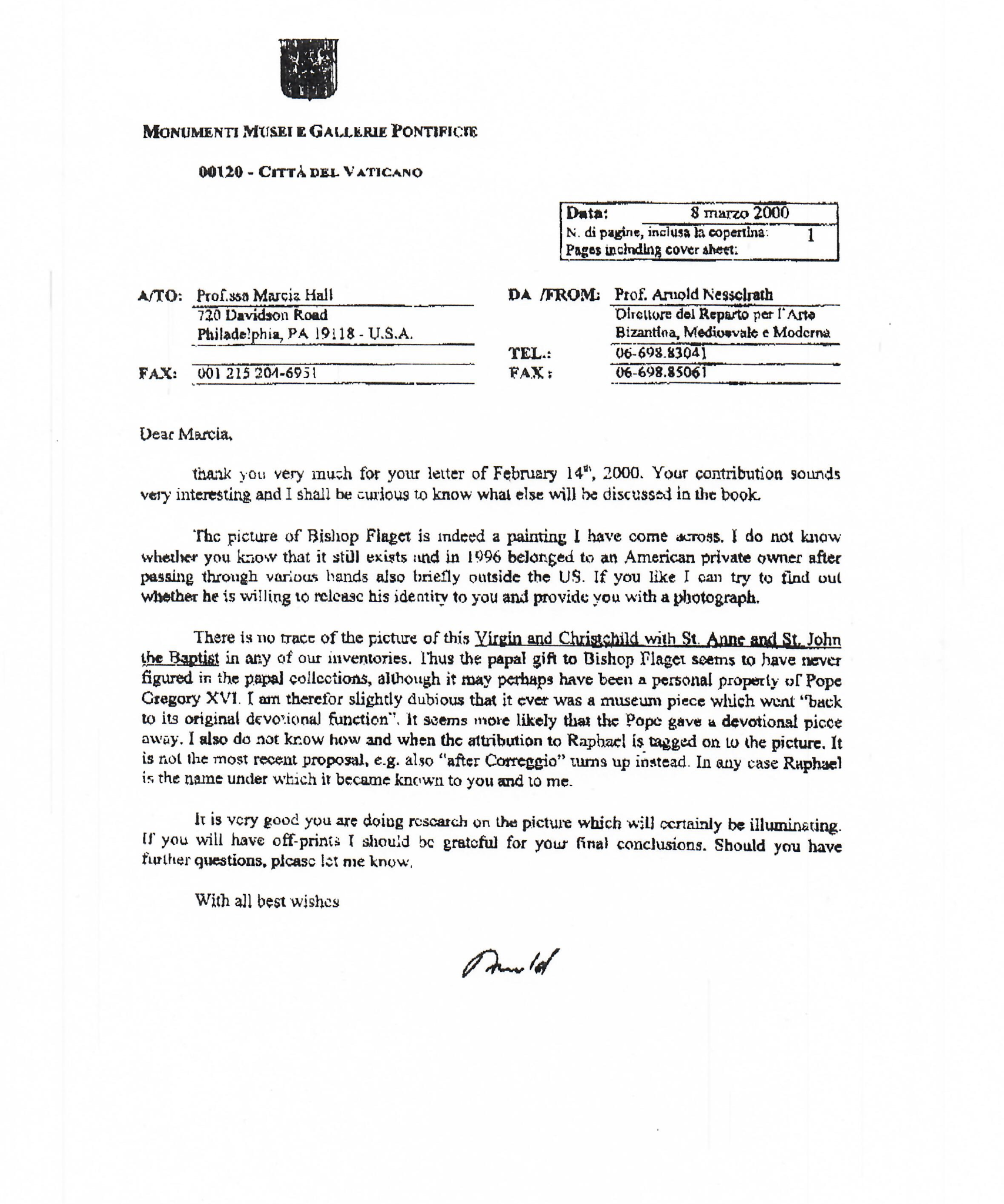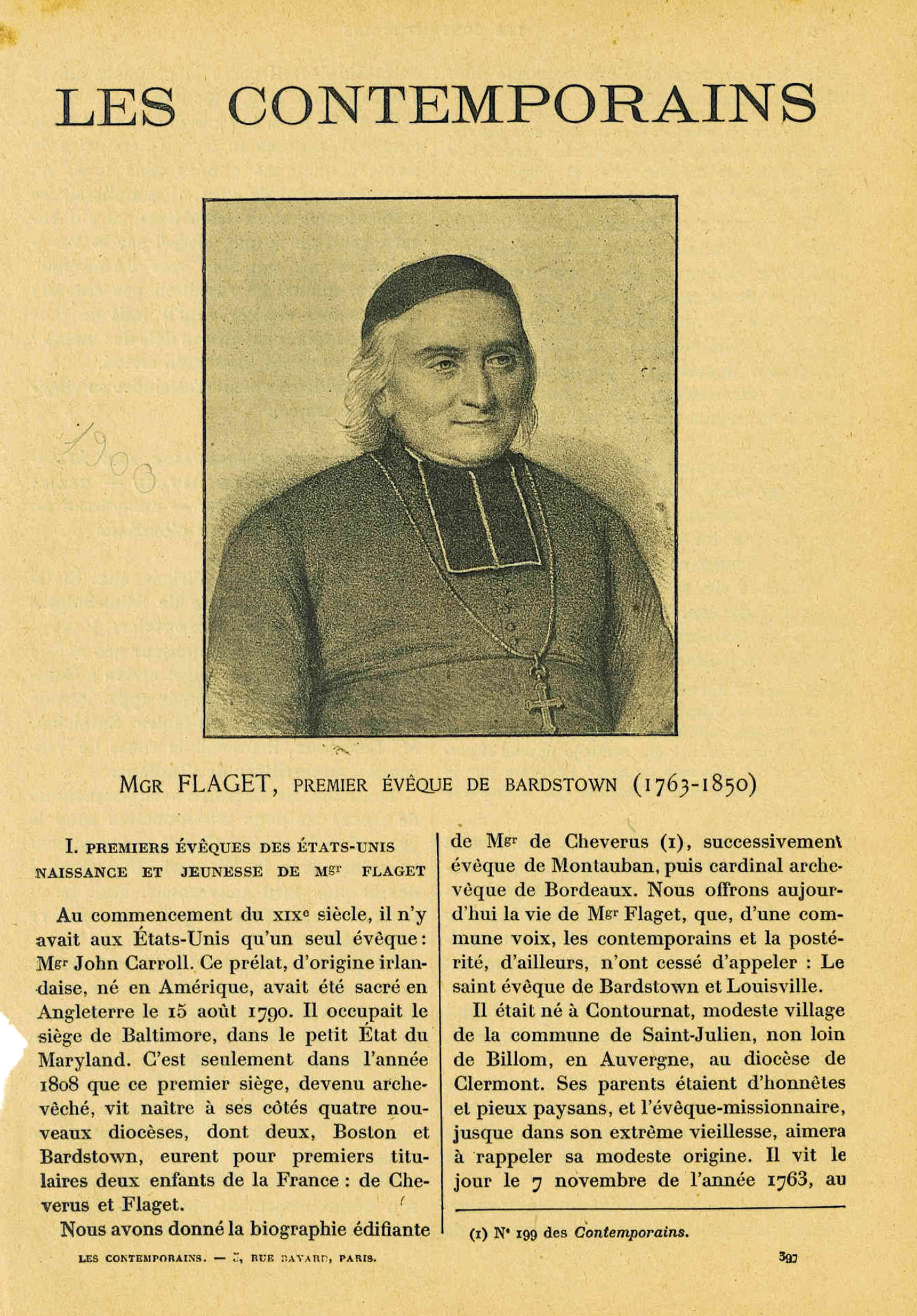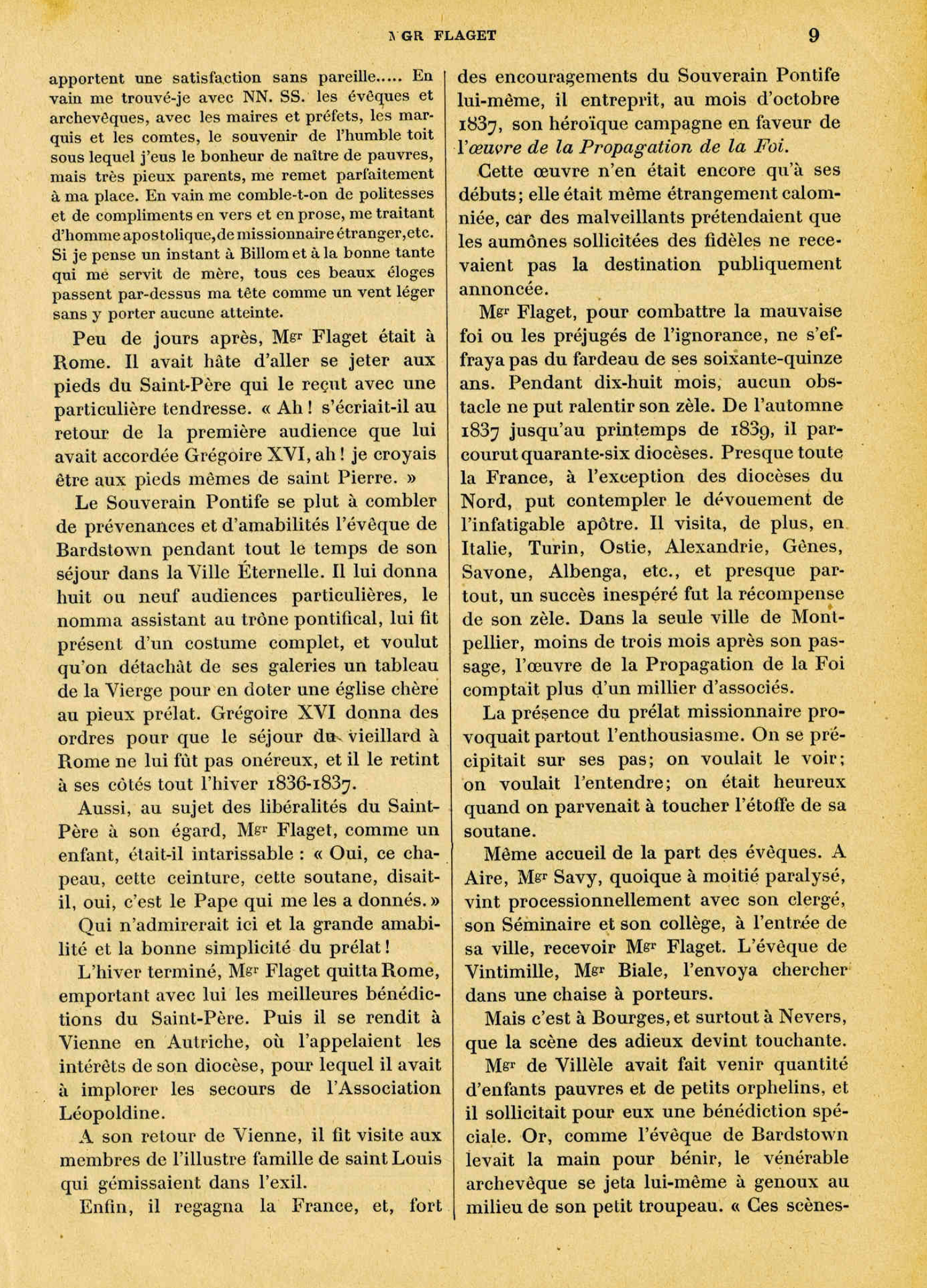No known Raphael currently includes only the four figures in the Flaget Madonna. Whenever these four figures are found in known Raphael paintings, the figure of St. Joseph is also present. However, there are many references to a Raphael painting depicting the same four figures found only in the Flaget Madonna.
Raphael’s Flaget Madonna Provenance
C.1504-1570 - Della Rovere, Dukes of Urbino
C. 1504 - Giorgio Vasari mentions another painting, believed to have been a Madonna, which is likely the Flaget Madonna, as follows:
"After Ridolfo had studied from that cartoon and had become well-practiced in painting under Fra Bartolommeo di San Marco, he already knew so much, according to the judgment of the best masters, that Raffaello, when about to go to Rome at the summons of Pope Julius II, left him to finish the blue drapery and other little things that were wanting in the picture of a Madonna that he had painted for some gentlemen of Siena’.”
This painting was supposed to have been completed at the time of Raphael's departure to Rome in 1508, the same period we believe the Flaget Madonna was completed. For many years the painting Vasari mentions were thought to be the Louvre's La Belle Jardinière. In c.1983, the Louvre examined the painting to determine if the blue of the Virgin's clothing was completed by a second hand. Their results indicated that the paint layers of the blue cloth were homogonous and unquestionably completed by a single hand at the same time and that historians would have to look elsewhere for the painting Vasari referred to in the statement above.
1508, April 21 - The Flaget Madonna was commissioned by the 'prefettessa' Giovanna Feltria della Rovere and mentioned in Raphael's letter of April 21, 1508, to his uncle Simon Carla. In the letter, he refers to an "Our Lady.” The prefettessa was the mother of Francesco Maria della Rovere, Duke of Urbino, and sister to Elisabetta, the last Montefeltro Duchess of Urbino.
C. 1548 - The Flaget Madonna is one of the two Madonnas of Raphael's Florentine period, mentioned by Giorgio Vasari (in his Lives of the Painters, Sculptors, and Architects) on his visit to the Della Rovere in 1548, as follows:
"Thus, while staying there, Guidobaldo da Montefeltro, then commander of the Florentine armies, painted two small Madonnas in his later [Florentine] style, which were extremely beautiful. Today they are in possession of the Most Illustrious and Excellent Guidobaldo, Duke of Urbino."
1570-1598 - Lucrezia d'Este, Duchess of Urbino
Duke Guidobaldo della Rovere made a wedding or betrothal gift to his son’s bride Lucrezia d’Este (sister of Alfonso II, Duke of Ferrara) of “a Madonna of Raphael" The marriage was an unhappy one, and a divorce was received in 1576. At that time, Lucrezia returned to Ferrara. The Flaget Madonna went with her. Much turmoil surrounded her remaining years in Ferrara (including the dying off of the male line of the d’Este, and the Dukedom devolving to the papacy). Shortly before she died in 1598 (probably to prevent her possessions from being inherited by the illegitimate line of the d’Este family), she changed her will to bequeath her collection to Cardinal Pietro Aldobrandini (the grandson of Pope Clement VIII), who Pope Clement VIII had sent to oversee the transition of the D’Este properties to the papacy, and with whom she had developed a close friendship.
1598-C.1600 - Cardinal Pietro Aldobrandini
The grandson of Pope Clement VIII, Lucrezia's heir, retained the Flaget Madonna.
Shortly after the death of Lucrezia, the Duke of Urbino began writing to Cardinal Pietro Aldobrandini to have returned from the estate of his late wife, a Madonna by Raphael; during this time frame, no Raphael Madonnas are listed in the Duke’s collection. The Duke promises in the correspondence to provide an excellent copy of the painting to the Cardinal if he returns it.
C.1600-1631 - Francesco II della Rovere, Duke of Urbino
The Duke of Urbino receives the Flaget Madonna back after numerous letters (many still survive) to the Cardinal requesting the painting be returned. The Duke’s collection shows a Madonna by Raphael back in the collection, and the entry describes the Flaget Madonna.
1631-1634 - Vitoria della Rovere
Vitoria della Rovere inherits the collection from the last male of the Della Rovere Dukes of Urbino line. She is engaged to the Medici Grand Duke of Tuscany at the time. The Flaget Madonna painting shows up in the inventory of items sent to her in Tuscany.
The Della Rovere inventory of 1631 describes the artworks being packed for shipment to Vittoria after the death of the Duke. The Flaget Madonna is believed to be no. 9 in this inventory, as follows (a translated transcription):
“One large painting. A Madonna on a panel with Christ, St. John the Baptist, and another figure, by the hand of Raphael of Urbino.”
Note: The “other figure” is identified in the 1623-4 inventory of the Della Rovere as St. Elizabeth.
It is important to note that only one Raphael Madonna is listed in the 1623 and 1631 inventories of the Della Rovere collection. That one describes a Madonna and Child with Saint Elizabeth and Infant St. John, the same subject as the Flaget Madonna, and more importantly, a subject that NO KNOWN Raphael can be described as.
1634-1796 - The Medici Family
Raphael’s Flaget Madonna is absorbed into the Medici Collection at the marriage of Vitoria della Rovere to the Medici Grand Duke of Tuscany. Vittoria’s inheritance represents the most significant single expansion of the Medici collection, including several paintings by the great master Raphael. Upon the death of the last Medici heir, the Flaget Madonna and other assets of value were passed to the Papal State.
1796-1836 - Pope Gregory XVI
Pope Gregory XVI is known to have been acquiring significant paintings while still a Cardinal and continued buying after ascending the Papal Throne. Raphael’s Flaget Madonna is absorbed into the Pope’s private collection.
Pope Gregory XVI gifts Bishop Flaget a painting of a Virgin on, or soon after, September 29, 1836, from his collection. Dottssa Edith Cicerchia (at the time, acting Director of the Vatican Museums) has verbally indicated (and Arnold Nesselrath, one of their curators, has followed that with written confirmation) that the museum believes the Flaget Madonna is the painting mentioned in this account. Flaget had arrived in Rome after traveling extensively in France and attempting to raise funds for “church furnishings” for his struggling church in Kentucky. During his travels, Bishop Flaget is said to have performed seven “miracles’, which Pope Gregory XVI knew. Perhaps the Pope believed himself to be in the presence of a saint…
Raphael’s Flaget Madonna was mentioned in Pope Gregory XVI’s and Bishop Flaget’s private diaries that Pope Gregory XVI gave to Bishop Joseph Flaget - “to take back and endow a church dear to the heart of the Holy Bishop.” The Pope’s account (through his private secretary) follows:
"We had the happiness," he wrote, "to hear the holy Bishop tell us himself about his first interview with the Sovereign Pontiff. He was that day overcome with joy (...) I did not need to ask anyone about protocol; he carried all written in his own heart. In a few minutes, he found himself humble and prostrate at the feet of Gregory XVI. He was overcome by a feeling of happiness that elated him. He could not get up. The Sovereign Pontiff helped him with both hands, then warmly embraced him, and Bishop Flaget, once he had regained his composure, said to him: "Ah! I thought I was at the feet of St. Peter."
The reputation of the Bishop of Bardstown had preceded him to Rome; one can picture how Gregory XVI welcomed him. He eagerly inquired what had become of his precious health during that last illness; he showed him with caresses, granted him eight or nine private audiences, named him Bishop Assisting at the Pontifical Throne, made him a present of a complete outfit, and wanted him to take from his galleries a painting of the Virgin to endow a church dear to the heart of the holy Bishop. He retained him in Rome as long as he could, gave orders that his sojourn should not become too demanding, and when once the prelate wanted to leave the Eternal City, he (the Pope) opposed him, saying that he needed to stay, that the winter was not a season when an old man ought to undertake long voyages.
Bishop Flaget was confused with all these honors (...) He contemplated himself with unspeakable happiness under the raiment that he owed to the goodness of Gregory XVI. He said to whoever wanted to listen to him: 'This hat, this belt, this cassock, it is the Pope who gave them to me.'"
"September 29, 1836, has gone to the Palace at ll:00 a.m.; he was immediately introduced to the presence of the Father of all the Faithful. Conforming to the usual protocol, I made the three genuflections, and on the third one, I kissed the cross embroidered on his sandal; it seemed to me I was kissing the feet of St. Peter himself. At that thought, my heart experienced a sensation I could not describe; sighs and sobs prevented me from speaking. According to protocol, I should have remained kneeling until the Pope gave me a sign to get up; but in that audience, all loving and fatherly, no ceremony was to be observed. The Excellent Pontiff stooped, took me in his two arms, and, when I was disposed to kiss his ring, he pressed me to his heart and embraced me tenderly while kissing me with Peace on both cheeks.
The impression these marks of friendship made on my heart was such that I couldn't articulate a single word, and I felt faint. At this sight, the Pope was moved. He pressed me to his breast again and embraced me tenderly; he invited me to regain my composure, made me sit near him, and, taking my two hands in his, he waited until I could open my heart to him (...) Fortunately for me, tears succeeded my sobs; they flowed freely. Then the pope embraced me for the third time.
Having recovered the use of my senses and feeling from then on entirely at ease, I entered into conversation with this sound and Excellent Father of the Faithful. Our interview lasted more than a half-hour and was made in Latin, and he assured me that he understood me perfectly.
As I spoke to him of my journey, of the malady of illness in Angers, and of the Confirmations which I had given at Nantes, he interrupted me, saying to me that he had followed all my steps since Le Havre until I arrived in Rome, that he was satisfied by my conduct, that I was a worthy successor of the Apostles, etc. Oh! How pleasant are such conversations! All The past sufferings appear now as nothing. No, I shall never forget this interview so paternal. It (the interview) has remained engraved in my memory all day and at each of its instants."
1836-C.1984 - Bishop Joseph Flaget
Benedict Joseph Flaget (b. 1763 in Auvergne - d. 1850 in Louisville, Kentucky) was a French Sulpitian priest appointed the first Archbishop of the “Northwest Territory” of the United States in 1808, but fought the appointment and didn’t arrive in Bardstown until 1810. His territory included the states of Michigan, Wisconsin, Illinois, Indiana, Ohio, Kentucky, Tennessee, and parts of Missouri. He took it upon himself to overlook what is now the state of Alabama.
The Bishop loved the arts and made it his mission to introduce culture to his archdiocese by bringing artworks from the ‘Old World’ (Europe) to favor the ‘New World’ (America). The fact that he was extraordinarily well connected with the aristocracy of Europe, as were several of his priests, permitted the formation of the Bishop Flaget Mission Collection, which contained many hundreds of paintings at its peak. During a visit to Europe by Flaget (1835-1839), he is recorded as having performed seven ‘miracles.’ Flaget had already been ‘hailed the conquering hero’ in Europe, particularly France, as the frail French Bishop taming the New World's wilds. His ‘miracles’ merely fanned the flames of the fire of his popularity (obviously facilitating his mission of collecting more artworks from the nobility of Europe).
The Bishop was befriended by the ‘Immortal Kentuckian’ Henry Clay, at that time Secretary of State and several times a candidate for the Presidency of the United States. Their friendship is evident by the fact that on a visit by Flaget to Washington, Clay invited him to his home to introduce the Bishop to the then President, John Quincy Adams. This contact was to prove helpful in the formation of the Mission collection.
On at least two occasions (1825 and 1832), Henry Clay interceded with the United States Congress to return to the Bishop import duties he had paid on artworks brought in from Europe. Copies of the records of the debates in Congress, as well as the original import documents and Treasury Department reimbursements to Flaget, were compiled by a Congressman from Kentucky, the Honorable Ben Johnson, in June of 1924, a copy of which is available for study. An issue of the debates was that these items were gifts from such notable personalities as the King of France, the Pope, and the King of the Two Sicilies, for the use of the Church. It would insult the characters to assign import duties on their gifts.
The collection Bishop Flaget formed was never intended to grace a single edifice but was to be disseminated throughout his archdiocese for the cultural enlightenment of his flock. However, most of the best works were kept near the archdiocese's seat (Bardstown and later Louisville, Kentucky).
When Flaget first arrived in Bardstown, he lived in the loft of a small log cabin (which still stands as a memorial to his works) with a few of his priests just south of Bardstown. In the lower floor of this log cabin resided the nuns of the area, who Flaget was to assist in forming into their convent, known today as the Sisters of Charity of Nazareth [the Flaget Madonna came from this convent]. On the first floor of this cabin, the sisters ran a school, and masses were performed. Very soon after his arrival, Flaget arranged to erect a proper, yet small, church beside the cabin, which also still stands, as a temporary measure until a Cathedral (known as the ‘Proto Cathedral’ although recently designated a basilica) could be erected in Bardstown. The Sisters of Charity of Nazareth, of Nazareth, Kentucky, the town immediately north of Bardstown, were to be the beneficiaries of many artworks Flaget brought to his Mission Collection. The sisters have, throughout their history, been instrumental in establishing educational institutions, which were of the utmost importance to Flaget in the settlement of his territory throughout the archdiocese in which he was Bishop.
Known Donors to Flaget Mission Collection
(With known dates of association)
Francis I, King of the Two Sicilies, A.K.A. the King of Naples (1827, 1832) Gifts of paintings from the King were made directly to Bishop Flaget, evidenced by an inventory dated 23 February 1827 which contains eight paintings and other objects (five of these paintings, one Mattia Preti and four Giovanni Battista
King Louis Philippe of France (1799 or 1837)
King (and Queen) of Sardinia; Charles-Albert (1839)
Duke of Angouleme (1837)
Pope Gregory XVI (1836) (as mentioned above)
Pope Leo XII (1832)
King of Piemont (1830’s)
Duke of Modena (1826)
Prince John Henry Cardinal de Frankenbergh (1800-1824)
Cardinal Joseph Fesch (1820’s)
Leopoldine Association, Vienna, Austria (1820’s – 1850’s)
C.1984-1980s - Antique Dealer near Bardstown Kentucky
The Flaget Madonna was purchased from the Sisters of Charity of Nazareth in Kentucky shortly after the painting had been inventoried in 1979.
1980s-1995 - English Antique Dealer
An English antique dealer purchased the Flaget Madonna from an American friend who was an antique dealer in Kentucky. It was then brought back to England.
1995-Present - Anthony Ayers
Ayers purchased the Flaget Madonna from an antique dealer in Cotswold, England, and brought it back to the United States, where it now presides.

Correspondence between Prof. Hall and Prof. Nesselrath confirming Raphael's Flaget Madonna as a "devotional piece" from Pope Gregory XVI's private collection, which was not inventoried by the Vatican and gifted to Bishop Flaget on September 29, 1836.

The meeting between Bishop Flaget and Pope Gregory XVI is recorded in detail in Bishop Flaget's private diary that still exists at the Louisville Diocese.
In addition: The Notre Dame University library archives show records of the meeting…
"The reputation of the Bishop of Bardstown had preceded him to Rome; one can picture the manner in which Gregory XVI welcomed him. He eagerly inquired what had become of his precious health during that last illness; he showered him with caresses, granted him eight or nine private audiences, named him Bishop assisting at the pontifical throne, made him a present of a complete outfit, and wanted him to take from his galleries a painting of a virgin in order to endow a church dear to the heart of the holy Bishop"
NOTE: The Sisters Of The Charity Of Nazareth convent, where the Flaget Madonna comes from, is known to be one of Bishop Flaget's preferred missions. No other Madonna painting appears in the convent's inventories.
The article from Les Contemporains, a period French magazine of the audience between Bishop Flaget and Pope Gregory XVI on September 29, 1836, describes Raphael’s Flaget Madonna as the gift of a "Virgin" painting (Madonna) from the pope's "Galleries"

